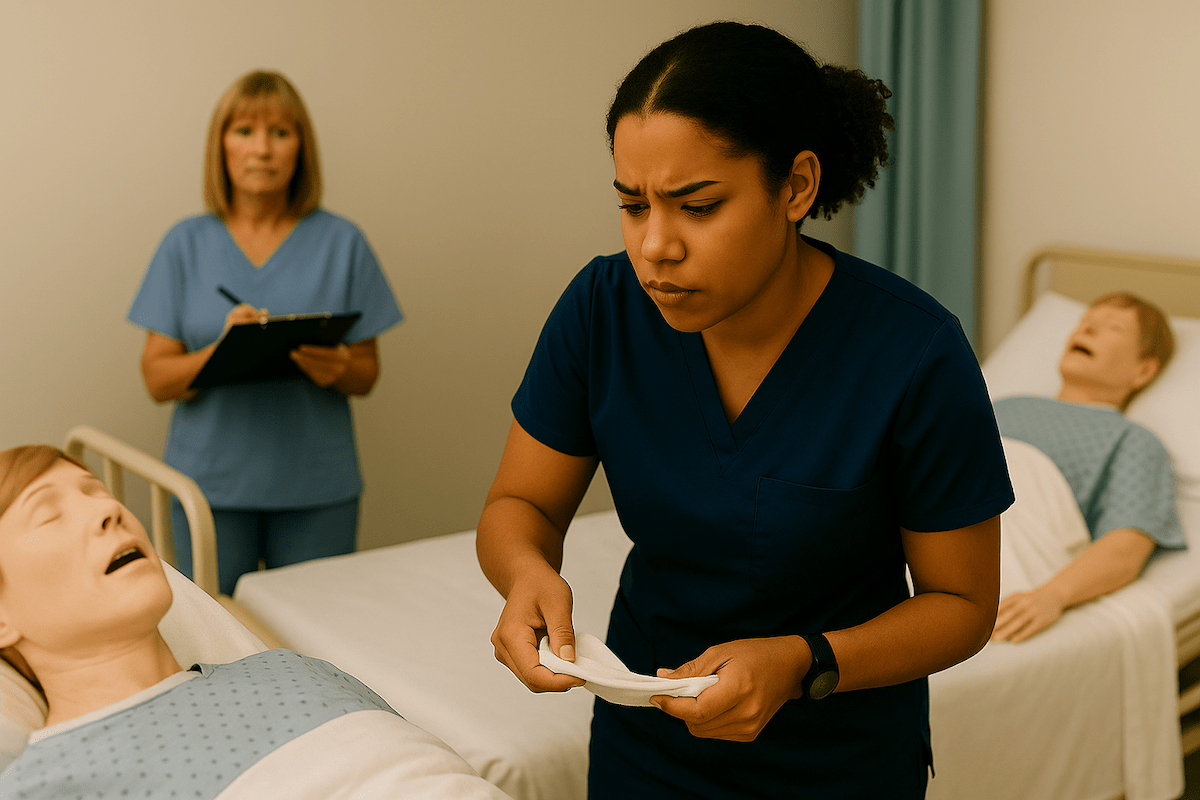
Manual blood pressure shows an 18% failure rate in CNA skills testing, but radial pulse counting consistently ranks among students’ most anxiety-provoking skills. Suppose you’re worried about losing the pulse mid-count or dealing with a partner whose pulse seems impossible to find. In that case, those concerns reflect real technical challenges that proper preparation can solve. Testing providers require radial pulse measurement on virtually every CNA skills exam because it’s fundamental to patient care.
What CNA Students Need to Know About Radial Pulse Testing
Why This Skill Appears on Every Test
Radial pulse appears as part of the measurement skills category that every candidate receives. Whether you’re testing with NNAAP, Prometric, or Headmaster, this skill represents core vital signs competency that practicing CNAs use daily.
The Universal Accuracy Standard
Your recorded pulse must be within ±4 beats per minute of the evaluator’s count across all testing providers. This margin ensures patient safety while accounting for natural variation in human counting.
Testing Environment Reality
CNA students frequently experience what one described: “So yesterday I took my skills exam and I failed because of RADIAL PULSE like bruh out of everything.” The testing environment creates pressures that classroom practice doesn’t replicate. You’ll count for 60 seconds while an evaluator watches and simultaneously counts to verify accuracy.
Program directors consistently find that students who understand each step’s purpose perform more reliably under pressure than those who simply memorize movements.
Master This Skill With Expert Video Guides
Join 6,000,000+ students who passed with Mometrix’s proven study system
Get Instant Access →8-Step Radial Pulse Technique for Testing Success
Step 1: Position Patient’s Arm
- Action: Place arm in supported position at heart level
- Testing Success: Prevents weak pulse detection that causes counting errors. Evaluators check that the arm isn’t dangling because unsupported positioning affects circulation.
Step 2: Locate the Radial Artery
- Action: Position index and middle fingertips on the thumb side of the wrist, one inch below the wrist crease
- Testing Success: Never use the thumb (it has its own pulse). The radial artery follows the radius bone path – this positioning ensures you’re in the correct anatomical location.
Step 3: Find Optimal Pressure
- Action: Start with light pressure, gradually increase until the pulse feels clear and strong
- Testing Success: Too much initial pressure compresses the artery and makes the pulse disappear. Think “tuning a radio” – find the pressure where the signal comes through clearly.
Step 4: Establish Pulse Consistency
- Action: Feel several steady beats before starting the official count
- Testing Success: Prevents the “fading pulse” problem. One student shared: “I got her pulse wrong because I couldn’t find it, and then I finally did find it, and it faded after beats.” Establishing consistency first prevents this exact failure.
Step 5: Align Timing Method
- Action: Start counting when the second hand reaches a clear number (like 12), plan to stop at the same position after 60 seconds
- Testing Success: Ensures accurate timing without shortcuts. All providers require a full 60-second count for accuracy.
Step 6: Maintain Count Focus
- Action: Count each beat without changing finger pressure or position throughout the full minute
- Testing Success: Any pressure changes cause the pulse to fade. Focus entirely on counting – evaluators watch for consistent technique.
Step 7: Record Immediately
- Action: Write as soon as 60 seconds end, before moving fingers
- Testing Success: Memory fails under pressure. Recording measurement is a critical element – failure to document causes automatic skill failure.
Step 8: Verify Documentation
- Action: Confirm the recorded number is realistic (60-100 bpm range) and complete the required forms
- Testing Success: Double-checking prevents obvious errors that cause failure even with accurate counting.
Solving the “Disappearing Pulse” Problem
Why Pulses Seem to Fade
Students unconsciously change finger pressure while concentrating on counting, or shift position slightly without realizing it. Community discussions consistently reveal: “I lose the pulse most of the time, and practicing this really didn’t seem to help much.”
Pressure Adjustment Without Panic
When the pulse starts fading, maintain current finger position and make small pressure adjustments – slightly lighter first, then slightly firmer. Avoid the common mistake one student described: “I tried putting my fingers everywhere, I pushed down hard, lightly, and normally at so many different places below the thumb.” This creates more problems than solutions.
Repositioning Strategy During Count
If the pulse disappears completely, make subtle finger adjustments without losing count. Slide fingers slightly toward the thumb or pinky side while maintaining skin contact. The artery follows a predictable path, so small movements along this path restore contact.
Body Type Variations
Some patients need fingers positioned toward the wrist center, others closer to the thumb side. Practice identifying the optimal position quickly for each person. This becomes invaluable when assigned testing partners with challenging pulses.
Accuracy Requirements and Documentation
The ±4 Beats Rule Across All Providers
- NNAAP Standard: Recorded pulse within ±4 beats of evaluator’s count
- Prometric Standard: Same ±4 beats tolerance
- Headmaster Standard: Identical ±4 beats requirement
This consistency reflects consensus on the accuracy needed for patient safety. One student experienced consequences: “I was 16 off because I lost the pulse in the middle of it and was trying to find it again” – this 16-beat difference far exceeds the acceptable margin.
Documentation Requirements
Recording the measurement appears as a critical element on all provider checklists. You must write your pulse rate on the provided form and often sign it. Even perfect counting fails the skill if documentation is missed or incorrect.
What Happens When You’re Outside the Margin
Measurements outside ±4 beats result in automatic skill failure. This tight standard ensures CNAs can detect pulse changes that indicate medical emergencies in real patient care.
Practice With 600+ CNA Exam Questions
See exactly how this skill appears on the real test
Radial Pulse Interactive Skills Checklist
Master each step with our interactive radial pulse checklist that lets you track your progress during practice sessions. Download the PDF version to bring to your skills lab, or use the digital checklist on your phone while practicing with study partners to ensure you’re completing every critical element evaluators will score.
Managing Test Anxiety During Pulse Counting
Performance Pressure Solutions
The 60-second observation period creates unique anxiety. Students report feeling rushed or distracted during this “simple” skill that determines certification success.
Confidence-Building Techniques
Before entering the testing room, practice the complete sequence until muscle memory takes over. Program directors note that demonstration followed by a return demonstration builds reliability under pressure.
Dealing with “Difficult” Partners
Testing anxiety increases when assigned partners with weak pulses. One student worried: “Before we went into the room, there was a group of us sitting in the waiting room waiting to test, and this girl couldn’t find her radial pulse.” Remember that evaluators understand pulse detection challenges and look for proper technique persistence.
Mental Preparation Strategies
Focus on technique consistency rather than speed. Evaluators want to see methodical, safe practice that translates to patient care, not rushed completion.
Provider-Specific Requirements: NNAAP vs. Prometric vs. Headmaster
Testing Assignment Differences
| Provider | Skill Assignment | Timing Protocol | Documentation |
| NNAAP | Individual radial pulse skill | 60-second count required | Recording sheet provided |
| Prometric | Separate pulse measurement | Full minute only (no 30-second doubling) | Measurement form required |
| Headmaster | May combine with respirations | Announce start/stop to evaluator | Pre-signed recording sheet |
Key Procedural Variations
Headmaster Difference: Some states test radial pulse and respirations together as a combined vital signs skill. This means both measurements must be accurate within their respective tolerances.
Prometric Emphasis: Explicitly scores arm support and proper finger placement as separate checklist items, not just final accuracy.
NNAAP Standard: Focuses on measurement outcome and critical safety steps, with technique details implied rather than separately scored.
State-Specific Considerations
Testing protocols can vary by state, even within the same provider. Check your specific state’s candidate handbook for any unique requirements or modifications.
Radial Pulse Video Demonstrations
Watch experienced CNAs demonstrate correct radial pulse technique from multiple angles to reinforce what you’ve learned in this guide. These video demonstrations show the finger positioning, pressure adjustments, and timing methods that help students achieve accurate counts consistently during testing.
Radial Pulse FAQ for CNA Students
All providers require 60 seconds of counting. Some allow a 30-second count doubled in practice settings, but testing requires a full minute for accuracy.
Use pressure adjustment and repositioning techniques while maintaining count. Evaluators understand detection challenges and look for persistent, proper techniques.
Your recorded count must be within ±4 beats per minute of the evaluator’s measurement. This standard is universal across NNAAP, Prometric, and Headmaster.
No, you have one 60-second counting period. Use repositioning techniques to maintain contact rather than restarting.
Adjust finger pressure and positioning using techniques practiced during training. Light pressure often works better than firm pressure for weak pulses.
Testing requires a full 60-second count. The 30-second method isn’t acceptable during skills evaluation.
Index and middle fingertips on the thumb side of the wrist, about one inch below the wrist crease, following the radial artery path along the radius bone.
60-100 beats per minute for adults. If your count falls far outside this range, double-check technique and positioning before recording.
Ready to Ace Your CNA Exam?
Get everything you need: video guides, practice tests, and detailed study plans





